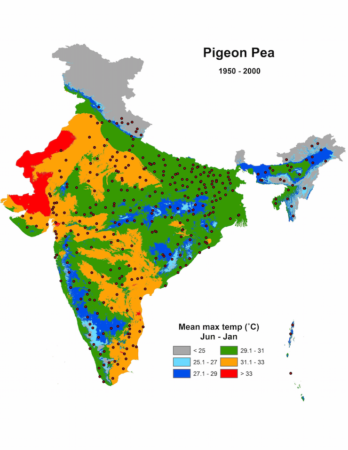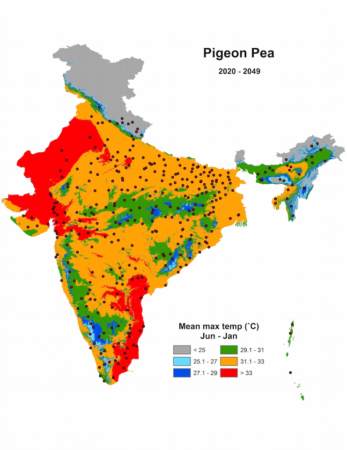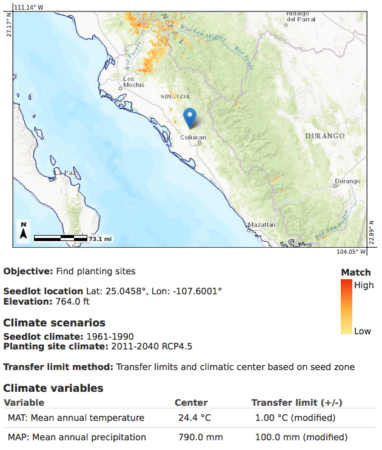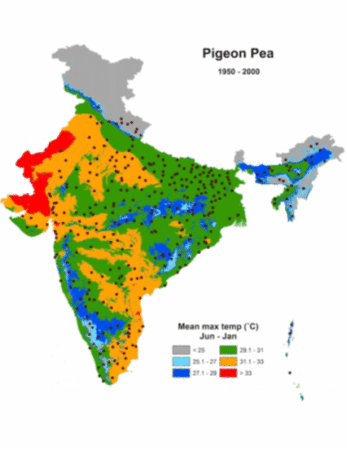- African rice out of Africa, and out of the genebank.
- The other way around for sweet potato.
- Markers for micronutrients. And diversity for taste…
- The deep history of the ginkgo.
- Study plants to decrease the effects of burping.
- Brazil rationalizes peanut collections.
- Measuring moisture in seeds.
- Big data for better seeds. And not only in Iowa.
- NZ seeds in Svalbard.
- CATIE on Genesys.
- Oz biosecurity fail. Better stick to online.
- I want to be a seed rebel too.
- Maybe in Kazakhstan?
- Agave under the volcano under the cosh.
An Indian pigeonpea GIF for the ages
Thanks to GIFmaker for allowing me to produce a, well, GIF, out of those maps of the distribution of India’s pigeonpea collection that I put up yesterday. I think you’ll need to click on it to get the full benefit.
Look at those swathes of green becoming orange, i.e. going up 2 degrees in mean maximum temperature during June-January. Will pigeonpea be able to adapt in situ? Or will there have to be a transfer of material from the currently orange areas? And what to do about the areas becoming red? Not much pigeonpea in the currently red areas…
Mapping the Indian collection
Always happens this way. No sooner do I find something interesting, that something similar turns up. Case in point my post last week on the Seedlot Selection Tool. It was just a few hours after I happened across the SST that I ran into NBPGR’s PGR-Clim. Ok, it’s not quite the same thing, but almost.
PGR-Clim maps out the Indian genebank’s holdings of chickpea, pearl millet, pigeonpea, sorghum and wheat on a background of rainfall and temperature now, in the 2020s and in the 2040s.
For example, here’s what the pigeonpea collection looks like relative to todays’s temperatures.

And this is relative to the temperature in the 2040s.

So it is possible now to find a pigeonpea accession with the sort of climatic (or soil) adaptation you need, and request it from NBPGR. All you need to do is locate it on one of these images (which you can download), then somehow remember where it is and find it again on the interactive map that PGR-Clim also provides, separately. If you then click on it there, you get an accession number, which you can cut and paste into the search box of PGR Portal. Hey presto!
Brainfood: Cannabis roundup, Citrus genomes, Mapping Africa, Maize diversity, Qat diversity, Language diversity, Apple taste, Coconut diversity, Napier grass review, Rangeland management, Chinese goats, Arabica evaluation, Bangladeshi chickens, Seed endophytes
- Cannabis Domestication, Breeding History, Present-day Genetic Diversity, and Future Prospects. The weed is in trouble, man. Just one of the papers in a very special issue of Critical Reviews in Plant Sciences. And for a historical perspective…
- Genomic analyses of primitive, wild and cultivated citrus provide insights into asexual reproduction. Apomixis is down to a “miniature inverted-repeat transposable element insertion in the promoter region of CitRWP.”
- Automated cropland mapping of continental Africa using Google Earth Engine cloud computing. Croplands increased by 1 Mha/yr between 2003 and 2014.
- Genetic diversity and population structure of native maize populations in Latin America and the Caribbean. Three groups: Mexico + southern S. America, lowland Mesoamerica + Caribbean, Andes.
- Phylogeography of the wild and cultivated stimulant plant qat (Catha edulis, Celastraceae) in areas of historical cultivation. Centres of origin in Kenya and Ethiopia, with limited movement between the two, but some hybrids in N. Kenya; the Yemeni stuff came from Ethiopia.
- Process-based modelling shows how climate and demography shape language diversity. If you assume human groups split after reaching a certain population size, and rainfall limits population density, you can predict language diversity in Australia.
- Volatile Compound Profiles of Malus baccata and Malus prunifolia Wild Apple Fruit. Look at the esters.
- Genetic diversity, population structure and association analysis in coconut (Cocos nucifera L.) germplasm using SSR markers. I can’t see much new here. Please, coconut experts, tell me what I’m missing.
- Opportunities for Napier Grass (Pennisetum purpureum) Improvement Using Molecular Genetics. Could do better.
- Heterogeneity as the Basis for Rangeland Management. Gotta mix it up.
- Analysis of genetic diversity of Chinese dairy goats via microsatellite markers. The locally developed breeds are all derived from a single European breed.
- Variation in bean morphology and biochemical composition measured in different genetic groups of arabica coffee (Coffea arabica L.). You can’t use morphology to predict taste.
- Breeding for the improvement of indigenous chickens of Bangladesh: evaluation of performance of first generation of indigenous chicken. I don’t understand this much, but I liked the names of the genotypes: Naked Neck, Hilly and Non-descript Desi.
- Persistence of endophytic fungi in cultivars of Lolium perenne grown from seeds stored for 22 years. It’s a record!
Targeting germplasm in an age of climate change
Let me expand a little on yesterdays’s teaser about the Seedlot Selection Tool.
Say you have an accession of maize, for example, collected 20 years ago, for example, somewhere in the middle the NW zone of Mexico defined by Orozco-Ramírez, Perales & Hijmans (2017), for example.
Say that you’d like to know where you could grow that material 20 years from now.
Say you have a few minutes to learn how to use the USDA’s Seedlot Selection Tool.
This is what you would get, more or less, depending on the details.

The blue dot is your collecting site, the red bits are the places where that material will be adapted in 2040. And you can run the thing the other way around too. That is, given that you want to grow something in 2040 where that blue dot is now, where would you have to have collected it in the past?
The Seedlot Selection Tool seems to be aimed primarily at forest and landscape managers, but I see no reason why it couldn’t be used in agricultural applications too, as above, subject to the same provisos.
The Seedlot Selection Tool (SST) is a web-based mapping application designed to help natural resource managers match seedlots with planting sites based on climatic information. The SST can be used to map current climates or future climates based on selected climate change scenarios. It is tailored for matching seedlots and planting sites, but can be used by anyone interested in mapping climates defined by temperature and water availability. The SST is most valuable as a planning and educational tool because of the uncertainty associated with climate interpolation models and climate change projections. The SST allows the user to control many input parameters, and can be customized for the management practices, climate change assumptions, and risk tolerance of the user.
Would love to get my hands on a global version.
